Standing at a primitive 1960s pinball machine, Chiang Wen-ching (
Though 50, Chiang is visibly most content when surrounded by the more than 1,000 kinds of toys that make up his vast collection assembled over 30 years and which he now displays at his own Taiwan Toy Museum (
On a recent visit, when a group of visitors is stumped on how to use a stringless top, he eagerly intervenes with a thorough explanation in a tone of affection not unlike a father introducing his child to his friends.
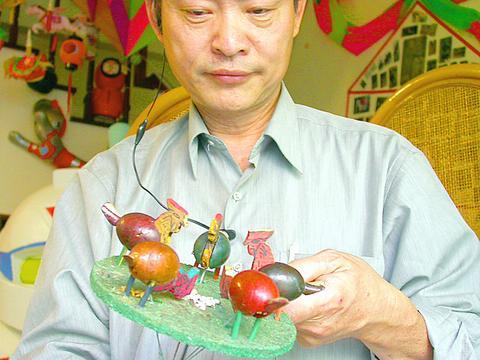
PHOTO: VICO LEE, TAIPEI TIMES
Nearly every visitor to this apartment-sized museum is subjected to Chiang's enthusiastic and detailed guided tour through the history of toys in Taiwan. And despite having opened only recently, and its out-of-the-way location on the edge of Taipei, a non-stop flow mainly of students comes here to test themselves on the traditional interlocked rings and marvel at other old Taiwanese toys most have never heard of.
Toys from antiquity
The displays are arranged in chronological order, starting with a reproduction of the prehistoric Yellow Emperor's soccer ball, made of his enemy's skull wrapped in straw, and tou-hu, a prototype dart-throwing game that dates to the Spring and Autumn Period about 2,500 years ago.
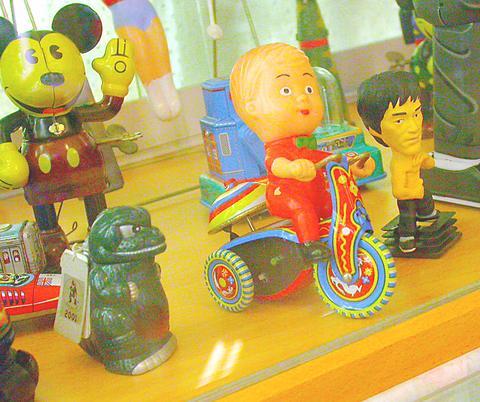
PHOTO: VICE LEE, TAIPEI TIMES
Another of the oldest toys on exhibit is a can car dating from the late Qing dynasty. It's simply a tin can attached to a bamboo stick, but has proven to be a hit with visitors of all ages.
"Toys from before the 1930s were mostly wooden gadgets or simple structures. At that time, whatever moved, had bright colors and made sound was a toy," Chiang said.
Some of the items are of particular historical interest. Chinese chess pieces dating from World War II, for example, were named after the military titles of that time, while pictures on a roulette table from the 1950s say: "Recover the mainland and eliminate communists."
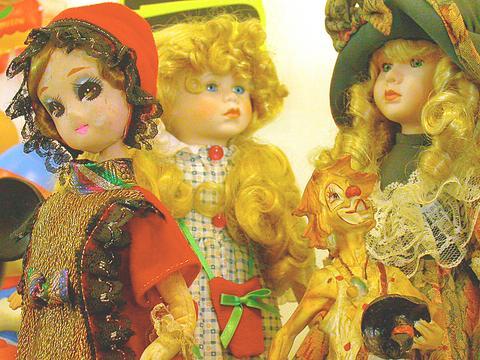
PHOTO: VICO LEE, TAIPEI TIMES
There's a large number of German iron toy cars from the 1970s and a full set of English matchbox cars, which are now worth thousands of NT dollars each.
Raised in rural southern Taiwan, Chiang started collecting toys in middle school, just when his friends were beginning to abandon theirs. "The economy was bad, so throwing away toys was wasteful. But maybe I just couldn't part with them because they're so much fun," Chiang said between tours for elementary school children.
Chiang has always surrounded himself with toys, taking his first job as a salesperson at a Matchbox car manufacturer's Taiwan branch and later working for a Japanese toy-model company. He later opened a convenience store, which, he said, sold more toys than food.
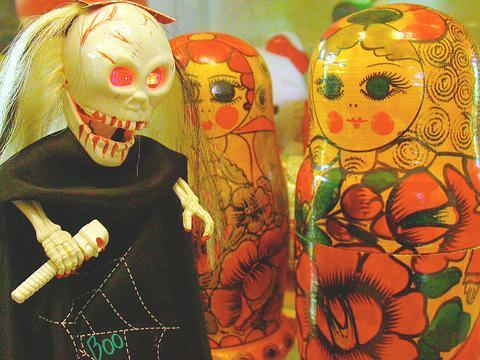
PHOTO: VICE LEE, TAIPEI TIMES
Lost for good
Old toys are disappearing fast, even at the flea market under Taipei County's Chung-xin Bridge, where Chiang acquired the bulk of his collection. Recently, he's turned to China as his new toy-hunting ground.
"It's hard to estimate how many kinds of toys Taiwan has had over the years, because people used to make their own toys. Maybe some inventions we'll never find again," Chiang said.

PHOTO: VICE LEE, TAIPEI TIMES
"There have been several elderly visitors who described to us the toys they used to play, but we have no idea what they are," said Chiang's wife, while busy assembling "cherries," a toy composed of two cherry-colored wooden balls connected by a string, which Chiang built from memory. By holding the middle of the string and pulling it in the right way, the two balls collide repeatedly, making a pleasant rhythmic sound.
"In the past, anyone could make toys with found objects, and they never tired of playing with them," Chiang said.
New-fangled toys ruin the fun
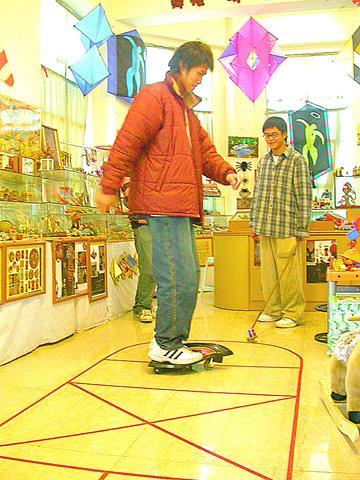
PHOTO: VICO LEE, TAIPEI TIMES
A revolution in the history of toys came in 1969, Chiang said, with the advent of the three wireless TV channels. Imported cartoons and foreign toy commercials changed people's tastes and before long Barbie and Mickey Mouse had replaced homelier straw human figures and plastic flying discs.
"Since then toys have become merchandise. You don't make your own toys. You pick a Snoopy or a Winnie the Pooh from store shelves. I used to take apart my toys to figure out how they work, but with Mickey Mouse, the educational function of toys was lost," Chiang said.
To revive interst in old toys, Chiang is looking for video game designers to work on on-line games based on old toys. Old toys as they are, Chiang admits, are no longer appealing to children. "Since every kid plays on-line games these days, maybe an old toy can be reborn in this new form."

PHOTO: VICO LEE, TAIPEI TIMES N
Believing in a connection between violent games and violent behavior, Chiang purposely left out the fashionable, bloody clawed Kumakikai and horror versions of Be@rbrick from the museum's displays, as well as realistic guns.
Of all his toys, Chiang says one particular toy gave him his best memories -- an 8cm water pistol. With this rubber pouch on a tube, a 10-year-old Chiang won many battles with his friends back in the day.
"I believe lovers of old toys are nurturing their inner child well, because these simple gadgets appeal to something universal. Here, even young visitors who have never heard of these toys have a good time with them. They touch the humanity in us all," he said.
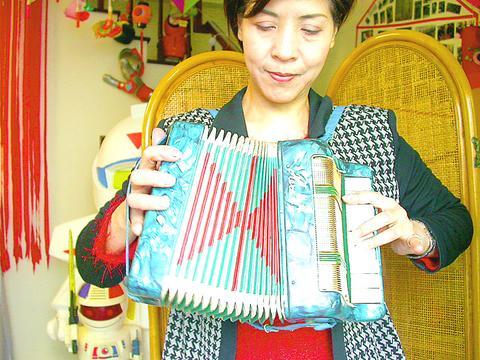
PHOTO: VICO LEE, TAIPEI TIMES
For your information :
Taiwan Toy Museum is located at 159, Jingye Rd,Taipei. (
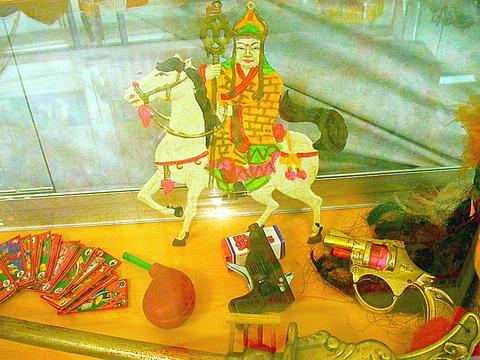
PHOTO: VICO LEE, TAIPEI TIMES

On April 26, The Lancet published a letter from two doctors at Taichung-based China Medical University Hospital (CMUH) warning that “Taiwan’s Health Care System is on the Brink of Collapse.” The authors said that “Years of policy inaction and mismanagement of resources have led to the National Health Insurance system operating under unsustainable conditions.” The pushback was immediate. Errors in the paper were quickly identified and publicized, to discredit the authors (the hospital apologized). CNA reported that CMUH said the letter described Taiwan in 2021 as having 62 nurses per 10,000 people, when the correct number was 78 nurses per 10,000

As we live longer, our risk of cognitive impairment is increasing. How can we delay the onset of symptoms? Do we have to give up every indulgence or can small changes make a difference? We asked neurologists for tips on how to keep our brains healthy for life. TAKE CARE OF YOUR HEALTH “All of the sensible things that apply to bodily health apply to brain health,” says Suzanne O’Sullivan, a consultant in neurology at the National Hospital for Neurology and Neurosurgery in London, and the author of The Age of Diagnosis. “When you’re 20, you can get away with absolute

May 5 to May 11 What started out as friction between Taiwanese students at Taichung First High School and a Japanese head cook escalated dramatically over the first two weeks of May 1927. It began on April 30 when the cook’s wife knew that lotus starch used in that night’s dinner had rat feces in it, but failed to inform staff until the meal was already prepared. The students believed that her silence was intentional, and filed a complaint. The school’s Japanese administrators sided with the cook’s family, dismissing the students as troublemakers and clamping down on their freedoms — with

As Donald Trump’s executive order in March led to the shuttering of Voice of America (VOA) — the global broadcaster whose roots date back to the fight against Nazi propaganda — he quickly attracted support from figures not used to aligning themselves with any US administration. Trump had ordered the US Agency for Global Media, the federal agency that funds VOA and other groups promoting independent journalism overseas, to be “eliminated to the maximum extent consistent with applicable law.” The decision suddenly halted programming in 49 languages to more than 425 million people. In Moscow, Margarita Simonyan, the hardline editor-in-chief of the